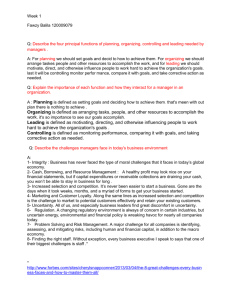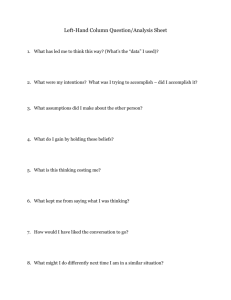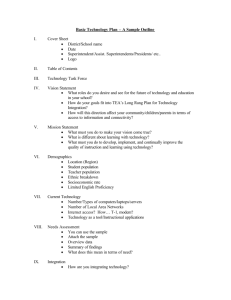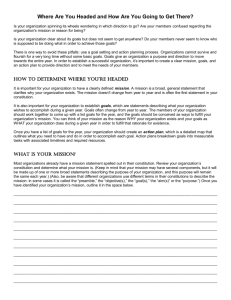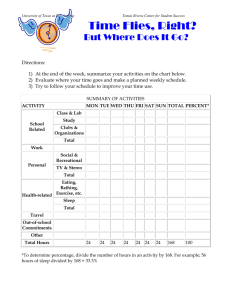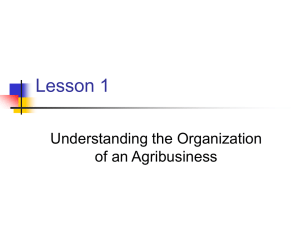Week 5 Part Two
advertisement
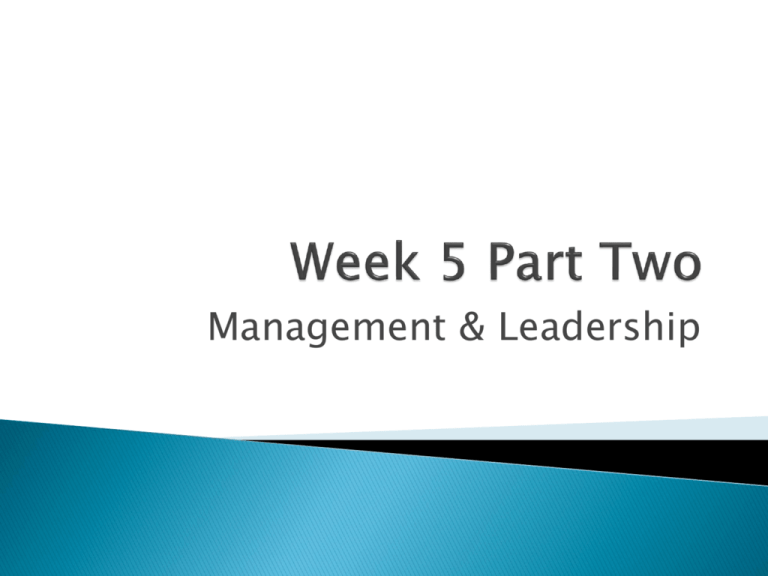
Management & Leadership Definition: The process used to accomplish organizational goals through planning, organizing, leading, and controlling people and other organizational resources. Planning Organizing Leading Controlling Definition: A management function that includes anticipating trends and determining the best strategies and tactics to achieve organizational goal and objectives The functions as following: Setting organizational goals Developing strategies to reach those goals Determining resources needed Setting precise standards Definitions: A management function that includes designing the structure of the organization and creating conditions and systems in which everyone and everything works together to achieve the organization’s goals and objectives The Functions as following: Allocating resources, assigning tasks, and establishing procedures for accomplishing goals Preparing a structure (organization chart) showing lines of authority and responsibility Recruiting, selecting, training , and developing employees Placing employees where they’ll be most effective Definition: Creating a vision for the organization and guiding, training, coaching, and motivating others to work effectively to achieve the organization’s goals and objectives The Functions as the following: Guiding and motivating employees to work effectively to accomplish organizational goals and objectives Giving assignments Explaining routines Clarifying policies Providing feedback on performance Definition: A management function that involves establishing clear standards to determine whether or not an organization is progressing toward its goals and objectives, rewarding people for doing a good job, and taking corrective action if they are not The Functions as following: Measuring results against corporate objectives Monitoring performance relative to standards Rewarding outstanding performance Taking corrective action when necessary Goals are broad, long-term achievements that organizations aim to accomplish Objectives are specific, short-term plans made to help reach the goals Strategic planning – broad, long-range planning that outlines the goal of organization Tactical planning – specific, short-term planning that lists organization objective Operational planning – sets specific time table and standards. Contingency planning – alternative sets of plan in case the first set doesn’t work 1. 2. 3. 4. 5. 6. 7. Define the situation Describe and collect needed information Develop alternatives Develop agreement Decide which alternative is best Do what is indicated Determine whether the decision was good one and follow up A Manager plans, organizes, and controls functions within an organization. A Leader has vision and inspires others to grasp that vision, establishes corporate values, emphasizes corporate ethics, embrace change and stress accountability & responsibity. Autocratic Leadership Participative (democratic) Leadership Free-rein Leadership Definition: Leadership style that involves making managerial decisions without consulting others This leadership style is effective in emergencies and when absolute followership is needed, also effective with sometimes new, relatively unskilled workers who need clear direction and guidance. Definition: Leadership style that consists of managers and employees working together to make decisions. Research has found that employee participation in decisions may not always increase effectiveness, but it usually does increase job satisfaction. This leadership style that values traits such as flexibility, good listening skills and empathy. Employees meet to discuss and resolve management issues by giving everyone some opportunity to contribute to decisions Many large organizations like Wal-Mart, FedEx, IBM, Cisco and most smaller firms have been successful by using this leadership styles Definition: Leadership style that involves managers setting objectives and employees being relatively free to do whatever it takes to accomplish those objectives This leadership style is often that traits include warmth, friendliness and understanding. Is the most successful leadership style in certain organizations, such as those in which manager supervise doctors, professors, engineers or other professionals. Setting clear standards Monitoring and recording performance Comparing performance with plans and standards Communicating results and deviations to employees Providing positive feedback for a job well done and taking corrective action if necessary Standards must be Specific Attainable Measurable Technical skills Ability to perform specific tasks such as selling products or developing software Human relations skills Ability to communicate and motivate Conceptual Skills Ability to see organizations as a whole and how all the parts fit together Imagine that one day you would like to be a manager. Here are some questions to get you started thinking like a manager: 1) Would you like to work for a large firm or a small firm? Private or Public? In an office or out in the field? Give your reasons for each answer 2) What kind of leader you would you be? Do you have any examples to show that? Please take out your note book or pieces of paper to copy down from white board!!!
